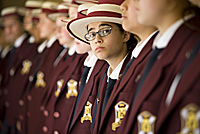Allow me, if you will, to illuminate for you two unwavering cinematic truths. First, in any film, if an adorable animal appears in the first act — especially if said creature is the only friend of an awkward child — that adorable animal is destined for death. Second, if a perky goes-her-own-way redheaded woman gets on a motorcycle without a helmet in the third act, she too will die.
I’m telling you this because it’s something every moviegoer should know. I’m also telling you in case you decide to watch Hey, Hey It’s Esther Blueberger at the Seattle Jewish Film Festival, so you’ll take care not to get emotionally attached to the duck. Or to Sunni’s mom.
To be fair, sandwiched in between these unnecessary deaths is a delightful and quirky coming-of-age story.
Esther Blueberger is the only Jewish student — or for that matter, the only student who isn’t tall, blond and blessed with perfect vision — at a private all-girls school in Australia. She is an oddball and an outcast and is understandably miserable. She gets no sympathy from her parents, who are busy preparing the details of the B’nai Mitzvah of Esther and her twin brother Jake, and following that, the siblings’ lives as attractive, popular, conventional teens. It’s an expectation neither Esther nor the equally offbeat Jake can ever hope to live up to.
The day of the twins’ coming of age is, somewhat predictably, the beginning of Esther’s quest for her own identity. She sneaks out of her Bat Mitzvah party and discovers Sunni, a punky-looking public school girl, lurking nearby. Esther invites Sunni into the party, Sunni encourages Esther to get drunk on kosher wine, and a life-altering friendship is born.
With the help of Sunni, Sunni’s equally cool motorcycle-riding mom (remember not to get too attached) and Sunni’s burnout friends, Esther decides to secretly stop going to her fancy private school and start attending public school instead.
Much of the film is dedicated to the often hilarious balancing act Esther must maintain between being the good prep-school girl for Mom and Dad and the rebel for Sunni’s cohorts. There are strange lies weaved, raincoats stolen, and Jewfro-sporting boys experimented upon. Ultimately, Esther concludes that she is neither the goody-two-shoes nor the bad girl, but rather her own person — an amalgam of something in between. But by then, Sunni’s mom is dead, Esther’s own family is on its way to fracturing, and neither school is a welcome environment.
The film never quite succeeds in picking of the pieces of the havoc wreaked at the climax, and the ending, though moving in the direction of “happily ever after,” feels forced. But then, a clean resolution may be too much to ask from as complicated a situation as adolescent identity crisis.
Saw that coming
